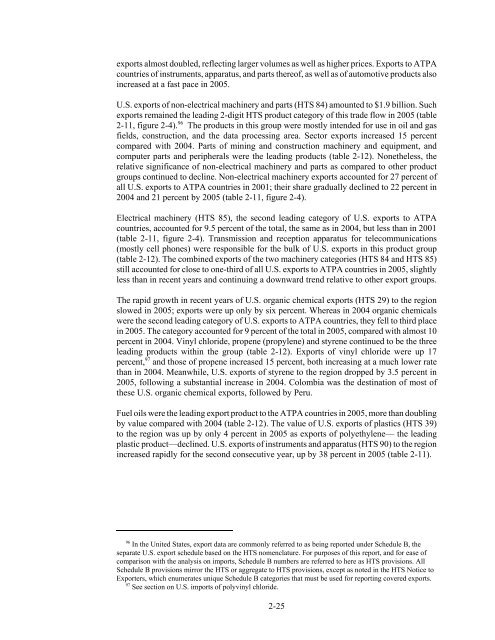The Impact of the Andean Trade Preference Act Twelfth ... - USITC
The Impact of the Andean Trade Preference Act Twelfth ... - USITC
The Impact of the Andean Trade Preference Act Twelfth ... - USITC
- No tags were found...
Create successful ePaper yourself
Turn your PDF publications into a flip-book with our unique Google optimized e-Paper software.
exports almost doubled, reflecting larger volumes as well as higher prices. Exports to ATPAcountries <strong>of</strong> instruments, apparatus, and parts <strong>the</strong>re<strong>of</strong>, as well as <strong>of</strong> automotive products alsoincreased at a fast pace in 2005.U.S. exports <strong>of</strong> non-electrical machinery and parts (HTS 84) amounted to $1.9 billion. Suchexports remained <strong>the</strong> leading 2-digit HTS product category <strong>of</strong> this trade flow in 2005 (table2-11, figure 2-4). 96 <strong>The</strong> products in this group were mostly intended for use in oil and gasfields, construction, and <strong>the</strong> data processing area. Sector exports increased 15 percentcompared with 2004. Parts <strong>of</strong> mining and construction machinery and equipment, andcomputer parts and peripherals were <strong>the</strong> leading products (table 2-12). None<strong>the</strong>less, <strong>the</strong>relative significance <strong>of</strong> non-electrical machinery and parts as compared to o<strong>the</strong>r productgroups continued to decline. Non-electrical machinery exports accounted for 27 percent <strong>of</strong>all U.S. exports to ATPA countries in 2001; <strong>the</strong>ir share gradually declined to 22 percent in2004 and 21 percent by 2005 (table 2-11, figure 2-4).Electrical machinery (HTS 85), <strong>the</strong> second leading category <strong>of</strong> U.S. exports to ATPAcountries, accounted for 9.5 percent <strong>of</strong> <strong>the</strong> total, <strong>the</strong> same as in 2004, but less than in 2001(table 2-11, figure 2-4). Transmission and reception apparatus for telecommunications(mostly cell phones) were responsible for <strong>the</strong> bulk <strong>of</strong> U.S. exports in this product group(table 2-12). <strong>The</strong> combined exports <strong>of</strong> <strong>the</strong> two machinery categories (HTS 84 and HTS 85)still accounted for close to one-third <strong>of</strong> all U.S. exports to ATPA countries in 2005, slightlyless than in recent years and continuing a downward trend relative to o<strong>the</strong>r export groups.<strong>The</strong> rapid growth in recent years <strong>of</strong> U.S. organic chemical exports (HTS 29) to <strong>the</strong> regionslowed in 2005; exports were up only by six percent. Whereas in 2004 organic chemicalswere <strong>the</strong> second leading category <strong>of</strong> U.S. exports to ATPA countries, <strong>the</strong>y fell to third placein 2005. <strong>The</strong> category accounted for 9 percent <strong>of</strong> <strong>the</strong> total in 2005, compared with almost 10percent in 2004. Vinyl chloride, propene (propylene) and styrene continued to be <strong>the</strong> threeleading products within <strong>the</strong> group (table 2-12). Exports <strong>of</strong> vinyl chloride were up 17percent, 97 and those <strong>of</strong> propene increased 15 percent, both increasing at a much lower ratethan in 2004. Meanwhile, U.S. exports <strong>of</strong> styrene to <strong>the</strong> region dropped by 3.5 percent in2005, following a substantial increase in 2004. Colombia was <strong>the</strong> destination <strong>of</strong> most <strong>of</strong><strong>the</strong>se U.S. organic chemical exports, followed by Peru.Fuel oils were <strong>the</strong> leading export product to <strong>the</strong> ATPA countries in 2005, more than doublingby value compared with 2004 (table 2-12). <strong>The</strong> value <strong>of</strong> U.S. exports <strong>of</strong> plastics (HTS 39)to <strong>the</strong> region was up by only 4 percent in 2005 as exports <strong>of</strong> polyethylene— <strong>the</strong> leadingplastic product—declined. U.S. exports <strong>of</strong> instruments and apparatus (HTS 90) to <strong>the</strong> regionincreased rapidly for <strong>the</strong> second consecutive year, up by 38 percent in 2005 (table 2-11).96 In <strong>the</strong> United States, export data are commonly referred to as being reported under Schedule B, <strong>the</strong>separate U.S. export schedule based on <strong>the</strong> HTS nomenclature. For purposes <strong>of</strong> this report, and for ease <strong>of</strong>comparison with <strong>the</strong> analysis on imports, Schedule B numbers are referred to here as HTS provisions. AllSchedule B provisions mirror <strong>the</strong> HTS or aggregate to HTS provisions, except as noted in <strong>the</strong> HTS Notice toExporters, which enumerates unique Schedule B categories that must be used for reporting covered exports.97 See section on U.S. imports <strong>of</strong> polyvinyl chloride.2-25
















